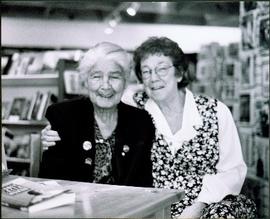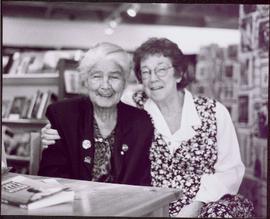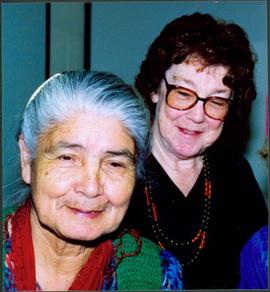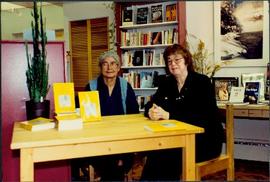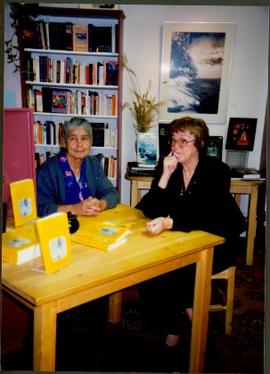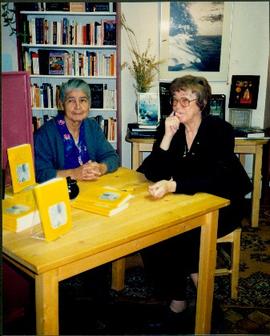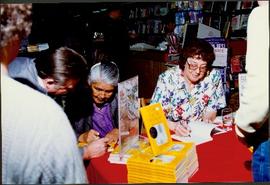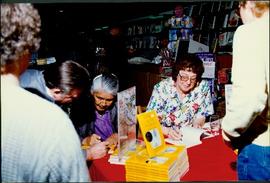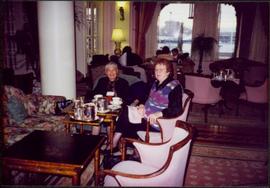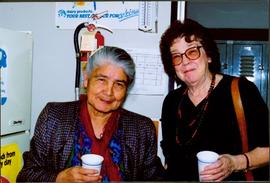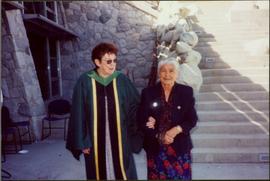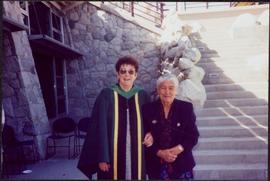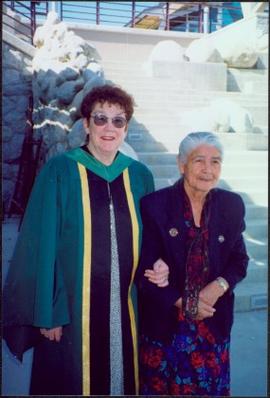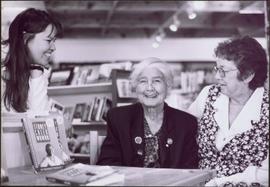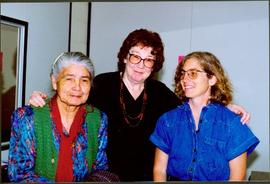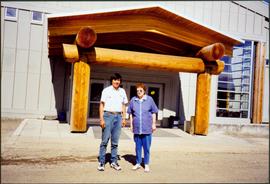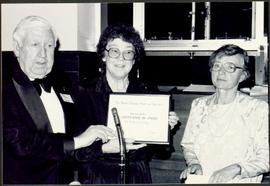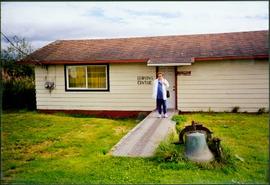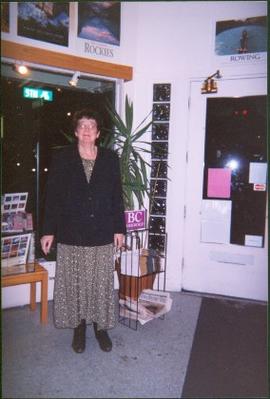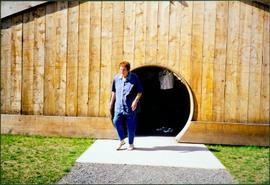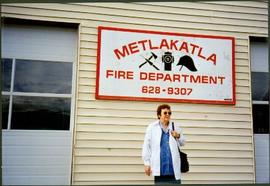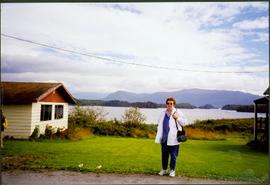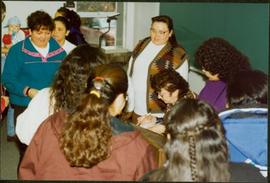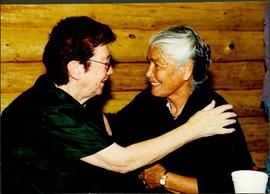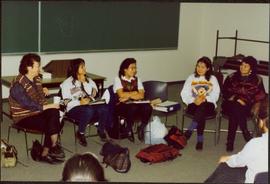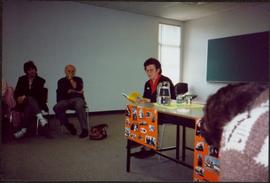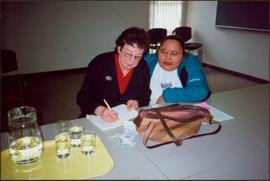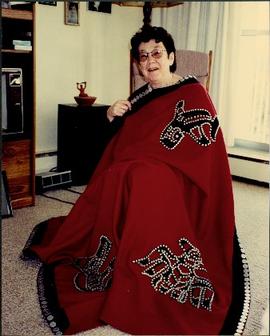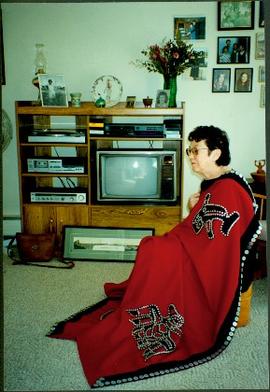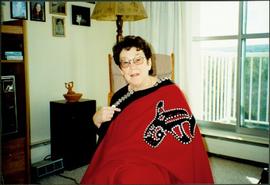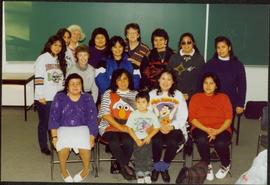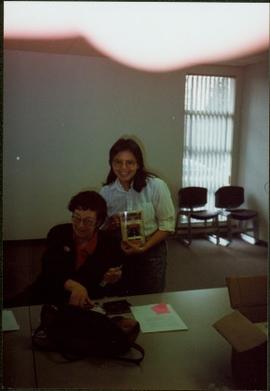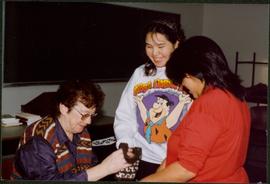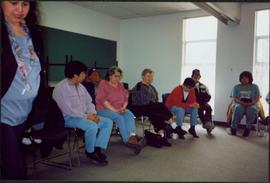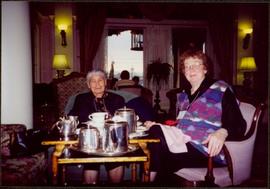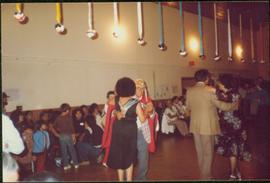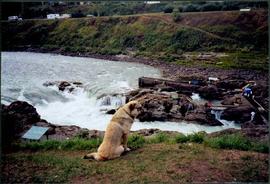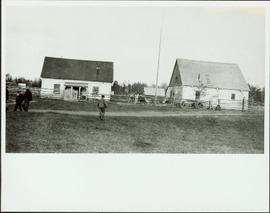Photograph depicts Moran with arm around Mary John, both seated at book display table. Bookshelves in background.
Photograph depicts Moran with arm around Mary John, both seated at book display table. Bookshelves in background.
Photograph depicts Bridget Moran standing behind Mary John in unknown room. Unidentified woman semi-visible on far right (see item 2008.3.1.19.2). Accompanying photo caption: "Caribou College, Quesnel, March /92".
Photograph depicts Mary John seated to left of Bridget Moran at book signing table. Copies of 'STONE CREEK WOMAN' displayed in foreground, plants and bookshelves in background.
Photograph depicts Mary John seated to left of Bridget Moran at book signing table. Copies of 'STONE CREEK WOMAN' displayed in foreground, plants and bookshelves in background. Accompanying photo caption reads: "First Autographing Nov 12/88".
Photograph depicts Mary John seated to left of Bridget Moran at book signing table. Copies of 'STONE CREEK WOMAN' displayed in foreground, plants and bookshelves in background.
Photograph depicts Mary John seated to left of Bridget Moran at book signing table. Copies of 'STONE CREEK WOMAN' displayed in foreground. Three unidentified individuals stand gathered around table. Bookshelves and computer in background. Accompanying photo caption reads: "Autographing - Woodward's - May 27/89. Taken by David Mah."
Photograph depicts Mary John seated to left of Bridget Moran at book signing table. Copies of 'STONE CREEK WOMAN' displayed in foreground. Three unidentified individuals stand gathered around table. Bookshelves and computer in background.
Photograph depicts Mary John seated to left of Moran at table in large room with tables, chairs, and couches. Skyscraper and water visible through window in background. Accompanying note reads "Tea at the Empress! Feb/97"
Photograph depicts Mary John and Bridget Moran holding paper cups in kitchen area, lockers visible through door in background (Moran on right). Accompanying photo caption: "Caribou College, Quesnel, March /92".
Photograph depicts Moran wearing regalia and linking arms with Mary John. Stone steps in background. The pair stands in the Agora courtyard at the University of Northern British Columbia in Prince George, B.C. Photo taken on the day Bridget Moran received an Honourary Law Degree.
Photograph depicts Moran wearing regalia and linking arms with Mary John. Stone steps in background. The pair stands in the Agora courtyard at the University of Northern British Columbia in Prince George, B.C. Photo taken on the day Bridget Moran received an Honourary Law Degree.
Photograph depicts Moran wearing regalia and linking arms with Mary John. Stone steps in background.
Photograph depicts Moran seated to right of Mary John at table displaying copies of 'Stoney Creek Woman'. Unidentified woman stands on left, bookshelves can be seen in background.
Photograph depicts Bridget Moran standing between Mary John (on left) and unidentified woman. Accompanying photo caption: "Caribou College, Quesnel, March /92".
Photograph depicts Moran standing with unknown man in front of building with large wood beams in entryway (see also item 2008.3.1.22.25 for image featuring Moran with this young man).
Handwritten annotation on recto: "Bridget Moran receives a Certificate of Merit from Don Sale and Naomi Miller of the B.C. Historical Federation Writing Competition Committee. May 13/89". Moran stands behind microphone, holding award, Don Sale and Naomi Miller on either side.
Moran stands on sidewalk in front of building with signs reading "LEARNING CENTRE" and "ST. PAUL'S ANGLICAN CHURCH". Large iron bell sits in grass in foreground, forest in background. Photo believed to have been taken near Metlakatla Lake, B.C.
Photograph depicts Moran standing in bookstore. Window, door, and plants in background. Photo taken at book signing event for Moran's 'Justa: a First Nations Leader'.
Photograph depicts Moran walking away from round entrance to long house, unidentified individual visible inside.
Moran stands in front of building with the sign "METLAKATLA FIRE DEPARTMENT 628-9307".
Bridget Moran stands on road, unidentified buildings behind on either side. Lake and hills on opposite shore in background. Photo believed to be taken at Metlakatla Lake, B.C. Building on left speculated to be the St. Paul's Anglican Church Learning Centre.
Photograph depicts Moran seated amongst standing group of unidentified women. Overhead machine and chalkboard in background. Photograph was taken at session of Aboriginal Women's Training Program at the Cowichan Campus, Malaspina University College, in Duncan B.C.
Close view of Bridget Moran seated to left of Mary John, both with a hand on the other's shoulder. Log wall in background.
Photograph depicts Moran seated on far left, in circle of women in classroom. Desk and chalkboard in background. Photograph was taken at session of Aboriginal Women's Training Program at the Cowichan Campus, Malaspina University College, in Duncan B.C.
Photograph depicts Moran reading excerpt from her book while seated beside table in classroom. Unidentified man and woman can be seen sitting in chairs against wall in background.
Photograph depicts Moran seated to left of unidentified woman at table with glasses and pitcher of water. Window and chalkboard in background. (Woman also featured in item 2008.3.1.102.2).
Photograph depicts Moran seated in chair at unknown location. Red and black button blanket features traditional thunderbird, wolf, and killer whale designs. Television, armchair, and window visible in background.
Photograph depicts Moran seated in chair at unknown location. Red and black button blanket features traditional thunderbird and killer whale designs. Television against wall in background.
Photograph depicts Moran seated in chair at unknown location. Red and black button blanket features traditional thunderbird and killer whale designs. Television, armchair, and window visible in background.
Photograph depicts a young boy and group of fourteen women posed for photograph in classroom, chalkboard in background. Handwritten annotation on recto of photograph: "Aboriginal Women's Training Program, Cowichan Campus, Malaspina University College, Duncan BC".
Photograph depicts unidentified woman holding copy of Moran's book, standing behind the author. Table in foreground, window and chairs in background.
Item is a recording of an audio segment from CBC Radio in which a documentary update is provided on the inquest of Coreen Thomas.
Audiocassette Summary
Scope and Content:
- Update on the case of deceased Coreen Gay Thomas
- July 3, 1976 Coreen Thomas is struck and killed by a car walking out to the Stoney Creek Reserve
- Police Report blamed Coreen for causing the accident saying that she was involved in a game of chicken
- The Driver of the car, Mr. Redekopp, had a high blood alcohol content but was not blamed for the crash
- Indians claimed that they were frequently harassed on the road by white motorists
- An inquest occurred and focused on relations between Indians and Whites
- Redekopp, coroner, police detachment, federal department of Indian affairs all seemed to be on trial
- Vanderhoof residents state media coverage is sensational with Vanderhoof unfairly labeled as “the most racially troubled town in Canada”
- Some see problem as due to lack of activities for young people in small communities
- Stoney Creek Indians live in intolerable conditions
- Interview with Stoney Creek Reserve resident regarding sanitation problems; lack of proper sewage system; cases of tuberculosis; high rate of unemployment; she states DIA should be responsible and should come up with a solution
- Problem with the perception of an alcoholic society;
- Archie Patrick, FN leader talks about the prejudice, harassment and racism found in Vanderhoof and other Northern communities towards Native People
- Good things could come out of this inquest – Vanderhoof residents should learn about poor living conditions at Stoney Creek
- Reporter provides update on the inquest; that local Police were accused of intimidating the witnesses
- Coreen Thomas’ death was unnatural but accidental
- Redekopp was negligible because vehicle was going too fast
- Segment of interview with Harry Rankin on the Thomas’ inquest; questions on the state of fairness of the inquest; and the state of white-native relations in northern BC
- Inquest Findings: Measures that should be put into place: Upgrade emergency system in the area, no person be placed in morgue before death certificate is in issue, get resident doctor for hospital, breathalyzers taken as soon as is legally permitted, RCMP officers be encouraged to have parent or guarding present when questioning young people as witnesses, Stoney Creek Band Council and Vanderhoof Council work to establish a Friendship Centre
Documentary ends with interview of Sophie Thomas on need for a change in white-native relations – and ends with excerpt of music from the Vanderhoof ‘pioneer’ song.
End of Tape
Item is a recording of an audio segment from CBC Radio in which CBC Reporter Karen Tankard provides a documentary report on the CBC Radio program Daybreak on conditions on the Stoney Creek reserve, outside of the farming community of Vanderhoof, 15 years after the inquest into Coreen Thomas’ death in Stoney Creek, BC. Tankard interviews community residents about the inquest and discusses the state of racism in the town of Vanderhoof, BC in 1991 and concludes improvements have not been made.
Audiocassette Summary
Scope and Content: Tankard recalls that Maclean’s Magazine had written at the time of the inquest that “Vanderhoof was one of the most racially prejudiced towns in BC”
Tankard recalls Inquest of Coreen Gay Thomas’ death and includes archived interviews from the 1976 inquest. One Vanderhoof woman says people are putting “racial connotations’ around what is going on in Vanderhoof and that she has ‘many friendships’ with native people that ‘is not unusual’ While Minnie Thomas, a Band Councillor in 1976, discusses how poor white-native relations are on reserve and criticizes the state of housing and the economy on the Stoney Creek reserve
Tankard then talks to students at a dance on the reserve on Sept 15, 1991; she notes there is no high school for the native students. Native student Kevin Prince notes that “white kids don’t like native kids…”
Jackie Thomas who works at the Band Office states that the feelings of racism still exist here in 1991 Yet Vanderhoof Alderman Jack French states that he “doesn’t see it” in Vanderhoof now. Tankerd notes that Native people recall that the Inquest “shamed” the federal government into making some changes – some municipal services now exist and roads are paved in Stoney Creek, yet there is still 80% unemployment and a rise in drug and alcohol abuse. Gordon Smedley, editor of the Nechako newspaper discusses white-native relations 15 years after the inquest – and argues that a ‘core group’ of drug users impacts the image of natives in the community
Stoney Creek Elder Mary John argues that racism still exists and refers to how in the case of one native woman, who was a university graduate that she could not get even a clerical job in Vanderhoof
Vanderhoof resident Hugh Millard – argues that native residents from Stoney Creek are “not hampered by prejudice, but by a lack of education”
Bruce Smith, high school principal, expresses the challenges of keeping native kids in school; that activities have focused on liaison work with the Band. Smith notes the creation of the Yinka Dene Language Institute as means to keeping native students in school - seen as a ‘storefront’ school for adult education
Tankard notes RCMP also attempting to make changes and have hired a native constable
Yet Alderman Jack French notes there is not a lot of contact between the municipal council and the Stoney Creek Band Council – however argues that the municipality has avoided getting involved in such issues – “not our mandate” – the municipality’s mandate is to provide municipal services only.
Tankard recaps the findings of the Inquest – and questions if anything has really changed in Vanderhoof and Stoney Creek since the inquest.
While she recalls that Richard Redekopp was charged with criminal neglect that resulted in Thomas’ death – that due to a lack of evidence he was not convicted
Tankard surmises that perhaps the hope of the inquest that a reunion of white-native community in Vanderhoof and Stoney Creek was ‘too much’ and ‘unachievable’
End of documentary report by Karen Tankard
The Daybreak female radio broadcaster (unidentified) then invites Talk Back listeners to call in on the issue…..
End of tape
Photograph depicts Moran seated to left of two students presenting small knitted craft. Desk and chalkboard in background. Photograph was taken at session of Aboriginal Women's Training Program at the Cowichan Campus, Malaspina University College, in Duncan B.C. Handwritten annotation on recto of photograph: "Gifts from Charlene + Joanne Smith".
Photograph depicts group of unidentified men and women seated in chairs in unknown classroom.
Photograph depicts Mary John seated to left of Moran at table in large room with tables, chairs, and couches. Skyscrapers visible through window in background. Accompanying note reads "Tea at the Empress! Feb/97"
Photograph depicts couples dancing in large room, crowd seated on chairs against wall in background. Ornaments are hung in a row from ceiling. Man dancing in centre wears traditional dress. Handwritten annotation on recto of photograph: "Elders gathering 1983".
Photograph depicts dog seated on grass in foreground. Unidentified individuals visible below with fishing nets in waterfall area at Moricetown Canyon.
Photograph depicts two buildings behind fence, sheds visible in background. Unidentified men can be seen walking in foreground. Small structures believed to be teepees can be seen behind fence.
Item is a audio interview recorded by Bridget Moran with Justa Monk.
Audiocassette Summary
00’ 05” Justa is talking about cutting wood for heat at home. He talks about wrecking his father’s axe. He continues to tell amusing stories about his childhood, which include his siblings and his father.
04’ 45” Moran asks Justa about how many employees he had when he was band manager. Justa talks about his work as band manager. They continue to talk about sawmills in the area. Justa discusses land rights as a result of the sawmills in their territory. Justa talks about tree farm licenses and the disputes between the band and the government. He talks about agreements the band has with Northwood Pulp and Timber Ltd.
16’ 35” Moran asks Justa about the note Theresa left him about being either a father or a band manager. They talk about this briefly.
18’ 23” Moran asks Justa about stories in his diary, such as trying to quit smoking. They talk about Justa becoming band leader. They continue to talk about Justa’s duties as general manager for the band and the politics surrounding the position.
25’ 14” Moran asks Justa about developing a school board for Tachie that is run by First Nations people. He wants to develop a proper curriculum that embraces the old way of life to maintain their culture.
30’ 40” Moran asks Justa why he stepped down as general manager for the band. Justa talks about someone else wanting the position. He also talks about the restraints on him. He talks about becoming tribal chief. He was given the mandate to deal with Kemano II, land claims, and developing forms of self-government.
41’ 15” Moran asks about the spread of AIDS in Tachie. Justa says, like cancer, it has spread because of stupidity. His people were healthy until the modernization of their society.
42’ 22” They return to discussing the opening of sawmills in the Tachie area, as well as tree licenses.
49’ 00” Moran asks Justa how many bands have dropped out of land claims issues. Ten remain, he tells her. They continue to discuss the issue of land claims.
50’ 47” Moran asks about when the tribal chiefs came together to have a common goal with regard to land claims. They continue to discuss land base, the progress of land claims, and the amount of people in each area. Justa talks about private companies entering their land and building private roads to log the area. They continue to talk about the politics of the position.
1:00’ 13” Moran asks Justa about his tribal chief position. He tells her it is a ‘twenty-four hour machine’ and to develop working relationships between the bands and the government, particularly with land claims and poverty issues. Justa continues to talk about his position.
1:09’ 11” Moran asks Justa which position he feels has helped his people the most. He tells her being band manager and tribal chief because he feels he has the right vision for his people that he can implement through clear direction and demanding certainty from the government, particularly with land claims. He talks about wanting to save the future of the nations and saving the river from the Kemano II Project. They continue to discuss the history of the Kemano II Project.
1:17’ 38” End of tape.
Item is a audio interview recorded by Bridget Moran with Justa Monk.
Audiocassette Summary
00’ 06” Justa is talking about the Kemano II Project and what he said in a meeting with the Ministers. He has asked them to stop the Project or they will face judicial review because they are basing the Project on a political basis, not a scientific basis. He says he feels he will win the case.
04’ 57” Moran tells Justa she is working on the chapter about when he kills his brother John. Moran asks Justa about what happened and he tells her all he remembers is when the cops arrested him. They continue to talk about what happened, though Justa’s memory is vague. Justa talks about his time in prison.
24’ 54” Moran asks Justa about when he moved to Fort St. James after he was released from prison. He moved to Dawson Creek after being picked arrested again.
27’ 58” Justa talks about moving back to Tachie, then going to work for BC Rail in 1970. At that time, he was hired as band manager.
28’ 50” They return to discussing the Kemano II Project.
32’ 20” Moran and Justa return to discussing the murder of his brother.
34’ 50” Moran and Justa talk about Brother Anderson, who worked at the residential school.
41’ 15” Moran talks to Justa about his brother Alec who passed away at a young age. The person who fell off a roof was a cousin.
42’ 30” Moran asks Justa about being left on Haldi Road when he was working at the rehabilitation camp. He talks about Haldi Camp and it was decent living conditions. There was no counselling offered.
47’ 57” Moran asks Justa if his troubles at that time were related to alcohol. He tells her that his fights were caused from drinking. He talks about his parents telling him they were worried about his drinking. He began to black out, but did not worry about it because he says he was young and did not pay attention.
49’ 55” After Justa left Dawson Creek, he returned to Tachie. Two weeks after he was home, Teddy was shot. They talk about the circumstances surrounding his death.
56’ 08” Moran asks Justa about his memories of Tachie when he started as a maintenance man in the 1970s. He says the roads were rough or hardly there. He talks about his job shovelling snow or pulling vehicles out of the mud. They talk about the Tachie community in the early 1970s. Justa talks about building the community up.
1: 08’00” Justa talks about his wedding to Theresa. Very few people attended the wedding. It took a long time for Justa’s family to recognize her as part of the family.
1: 12’ 54” Moran asks Justa about life in Tachie. Justa tells her things were done collectively, there was no division within in the community. He wishes the old way of life was still a part of the community. He talks about the love of ‘potlatch’ in the community. He talks about how the old way of life disappeared once the road was built.
1: 19’ 50” Moran asks Justa what he is working on. Justa says he is wrapping up the treaty process, budget proposals, and a couple other issues. He talks about Kemano II. He is serious about leaving his position because he has been neglecting his family. They continue to talk about the Kemano II Project.
1: 29’ 09” End of tape.
Item is a audio interview recorded by Bridget Moran with Justa Monk.
Audiocassette Summary
00’02” Justa is talking about the store in Tachie.
02’ 13” Moran asks Justa to clarify his different positions when working for the band, and when he served in those positions. He talks about the years he was band manager and tribal chief, and talks about these positions. He discusses the stress of the positions because of lack of funding.
16’ 29” Moran asks Justa about the different programs, such as water systems and education. Justa discusses getting the water system into Tachie. He discusses the details of trying to get the water system, particularly trying to get funding and getting the proper contractors. He talks about the stress of the position and how it affected his mind.
39’ 04” Justa talks about the differences between being a band manager and a tribal chief. He tells her there were no politics involved in being a band manager.
41’ 30” Moran asks Justa to draw her a map of Tachie and Sunnyside for the book, so she knows where everything can be found. Justa draws her a detailed map that includes the lake and the river.
52’ 34” Moran asks Justa about his week as a band manager and tribal chief, starting from Monday to Friday. He talks about his meetings involving contracts, social assistance, education, and other funding concerns. He reads from his diary to Moran.
1:02’ 55” Moran asks Justa about when Tachie received a telephone system. Justa talks about how he actually regrets getting a telephone and television system because of the loss of community.
1:08’ 55” Justa returns to talking about Kemano II.
1:14’ 59” Moran’s voice is muffled and incomprehensible.
1:16’ 35” Moran asks Justa for photographs for the book. Moran wants a subtitle for the book, so asks Justa for something in Carrier. Moran tells Justa that the CBC has asked why she is writing a book about him. They discuss the general details of the book.
1:26’ 17” End of tape.
Item is a audio interview recorded by Bridget Moran with Justa Monk.
Audiocassette Summary
00’ 01” Justa is talking about the Kemano II Project, which he states is a political issue, not an environmental one. He says the Project is a public issue now, not just a First Nations issue.
06’ 52” Moran asks Justa about when he was elected to tribal chief. He talks about the nominations process.
09’ 52” End of tape.
Item is a audio interview recorded by Bridget Moran with Justa Monk.
Audiocassette Summary
00’ 04” Moran is talking about book signings for Justa’s book.
00’ 27” Justa and Moran talk about board members for the Kemano II Project. They continue to talk about the Kemano II Project. Justa says the amount of pressure he is putting on the government, combined with public support, hopefully means Kemano II will be stopped. They continue to discuss the details and the politics surrounding the Project.
10’ 26” Moran asks Justa whether he was surprised or not when he lost the position of tribal chief at the last Assembly. He tells her he was not surprised. He talks about the first time he resigned from the position due to stress. He says the band knew he was tired, so did not want the position any longer. In a letter he wrote, he stated it was time for some new blood.
21’ 11” Moran asks Justa about his new position. He talks about being a contractor to Northwood Pulp and Timber where he liaisons between First Nations people and the company on employment concerns and tree sales. He talks about his position in more detail.
28’ 46” Moran asks Justa about how he feels about his life now. He tells her he feels good about what he has accomplished, but he needs a rest. He talks about his accomplishments throughout his career. He tells Moran he has no regrets about anything.
37’ 55” Moran asks Justa about his health issues and how he is feeling now.
38’ 57” End of tape.
Item is a audio interview recorded by Bridget Moran with Justa Monk.
Audiocassette Summary
00’ 10” Moran is asking Justa about how he is feeling because he had a major heart attack. He talks about recovering from his attack in a week.
02’ 15” Moran asks Justa about what he thinks about the Gustafson Lake situation. He says he predicted it because the government has not been serious enough in negotiations for land claims. He does not believe in militant reactions and wants peaceful negotiations.
04’ 54” Moran asks Justa about what helped him get out of the ‘trench’ he was in after murdering his brother. He was able to carry on partly because he was forgiven by his family and the elders. He says the elders were the people who convinced him to plan for his future. He took their advice seriously, hence why he took on leadership roles.
07’ 15” Justa talks about taking a group of students to meet Gino (?), a hockey player. He says he wants to make things better for the young people because of alcohol and drugs, so believed the trip helped the students he took on the trip.
13’ 34” End of tape.
Item is a audio interview recorded by Bridget Moran with Justa Monk.
Audiocassette Summary
00’03” Moran asks Justa how the Department of Indian Affairs party went at Other Art Cafe.
01’20” Moran tells Justa she has a number of questions regarding his political career. They talk about the number of bands in the area.
05’ 11” Justa talks about the nomination process for becoming tribal chief at the annual Assembly. He talks about when he was nominated and how he believed that he was nominated based on his character. Moran asks about the culture surrounding the Assembly, including entertainment. Justa tells her he did not participate in any of the activities.
12’ 41” Justa talks about his mother loving potlatch.
14’ 35” Moran asks Justa about the personal qualities it takes to be tribal chief. He tells her he was nominated because the people knew and trusted him.
16’ 03” Moran asks Justa about the role he played in getting the Department of Indian Affairs shut down. He tells her about leading a mandate to close the Prince George office through lawyers and the support of his people.
25’ 18” Moran asks Justa about the development of a school board for the reservations. He wants the school curriculum to teach the language and the culture. He has negotiated with the federal and provincial governments to implement these plans.
29’ 13” Moran asks Justa about his role in land claims. Justa talks about negotiating with the government to get some of the land back to his people. He has played a big role, he says, because he knows the area, the language, and the people. He talks about the long, drawn out process of planning the land claims concerns. Justa has a mandate as tribal chief to address land claims. He says the important part of the process is educating the people, white and non-white.
45’ 49” Moran is talking about Alcan locating grave markers to compensate for the damage done from the original Kemano project.
47’ 47” Moran asks Justa the role he has played in the Kemano II Project. He tells her that he took a big role because he saw the way of life being destroyed, never mind the environmental damage. He says he hates the concept of the project. Justa talks at length about the politics surrounding the Kemano II Project.
1:07’ 55” Moran asks Justa about which politicians he has met in his time as tribal chief. She encourages him to drop names. He lists a number of provincial and federal politicians.
1:10’ 45” Moran asks Justa about the Oka situation and any role he played in helping to negotiate the situation. He talks about an emergency Assembly. He discusses supporting the situation and telling his own people that they should not protest with the people from Oka to maintain peaceful land claims negotiations. He says he had to keep things calm in his own territory while offering support.
1:13’ 30” Moran asks Justa about the referendum regarding self-government. They talk about which way they voted.
1:16’ 20” Moran asks Justa about the consecration of the graveyards that were flooded by Kemano. He talks about how emotional the ceremony was and how much it hurt to be treated like second-class citizens. One woman described it as being chased out like a pack of coyotes.
1:19’ 50” Moran asks Justa about running for tribal chief again because he has unfinished business with the Kemano II Project.
1:20’50” Moran talks about the chapters of the book with Justa. They discuss some of the stories Moran is writing within the book.
1:28’ 42” End of tape.
Item is a audio interview recorded by Bridget Moran with Justa Monk.
Audiocassette Summary
00’ 10” Moran asks about when the roads were built to Tachie. Justa talks about the length of time it took to get to work from Tachie to Portage before the roads were built. After some people drowned, the pressure was put on the Department of Indian Affairs to build a road. Justa talks about his trips before the road was built.
07’ 42” Moran asks about why Tachie was not built around Stuart Lake but at the mouth of the creek. Justa gives a brief history of Tachie.
09’ 20” Moran asks Justa about the history of his father, particularly what his jobs were.
11’ 01” Moran asks Justa what Camp 24 is, where his mother and father stayed at times. It was a camp owned by the Roman Catholic Church where people could stay while they worked in the bush. Justa says the camp was more of a settlement. Moran and Justa continue to talk about the living conditions of Camp 24.
16’ 47” Moran asks Justa about his father’s mother. Justa never met his grandmother, even though his father continued to visit her. They continue to talk about the history of Justa’s parents.
20’ 10” Moran tells Justa she has heard there are no more gardens in Tachie today. Justa tells Moran that people no longer live off the land and that is why the gardens no longer exist. Justa says he feels lucky that he was able to experience life by living off the land. Moran asks about how home brew is made. Justa gives a list of the ingredients and how it needed to sit for twenty-four hours before being able to drink it.
25’ 00” Moran asks Justa about what his first memories of Fort St. James were. He talks about his childhood memories and his first experience in driving in a vehicle.
29’ 58” Moran asks Justa about how many families are in Portage. Fifteen to twenty are there, which Justa says is bigger than when he was growing up. There is a problem of over-crowding with about 300 people living there.
31’ 14” Justa talks about going into the cellar to collect stuff for his mother, such as jams. He talks about how his parents never ate any canned food, and always continued to live off the land. Justa continues to talk about the relationship between his parents and how happy they were together, how they rarely argued. When his mother passed away, his father passed away shortly after because he stopped taking care of himself.
36’ 44” Moran asks Justa about fishing. Justa talks about fishing from a reef in the fall. Justa would smoke the fish in a tent that other people had set up. He talks about living off the land, where nothing was wasted. In the winter, he would ice-fish.
41’ 00” Justa talks about how he enjoys going back to the old way of life and is looking forward to finishing his leadership position, so he can return to the old ways. He talks about rehabilitating his mind and body because he is burning out from his busy schedule.
43’ 06” Moran asks if she can talk to Justa’s sisters and a friend of his family. Justa tells her that his sisters are looking forward to speaking to her. They talk about the benefits of aging.
47’ 08” End of tape.
Item is a audio interview recorded by Bridget Moran with Justa Monk.
Audiocassette Summary
00’ 10” Moran is talking to Theresa, Justa’s wife. Moran asks her what Corpus Christi means. Theresa tells her it is a place where First Nations people from the area planted trees in a big circle. It was a prayer circle where the bishop would say mass.
05’ 10” Moran asks Theresa about Sports Day in Fort St. James, which was more like a rodeo.
06’ 17” Moran is now talking to Justa. Moran asks Justa about trips to Babine Lake that Jimmy previously mentioned. Justa does not remember the trips, but he imagines they were very cold.
09’ 17” Moran asks Justa about the store Jimmy used to run. Justa tells Moran the store was operating on the store credit, hence the downfall of the business. They continue to talk about opening a store in Tachie that is operated by someone with a strong business mind.
13’ 37” Moran asks Justa about a family member from Burns Lake that his sisters previously mentioned. Justa tells her that the family member is an aunt.
14’ 34” Moran asks Justa about the residential school. She enquires about his ability to play hockey. Justa never wore skates until he attended residential school.
16’ 03” Moran asks Justa about fishing with a safety pin. He tells her that one Indian can eat anything.
16’ 53” They return to talking about residential school and if Justa had ever returned. He went back when he was forty-five to visit the area.
18’ 34” Moran asks about the house his family used to live in. Justa is not sure about his brother’s story regarding the Hudson’s Bay Company. He is sure that the house they lived in was built byt heir family.
21’ 01” Moran asks about Justa’s brother who passed away when he was quite young. Justa says his mother told him his brother fell off the roof and broke his neck. They talk about Justa’s brother, Teddy, being killed.
24’ 04” Moran asks Justa about the community making their own snowshoes. Justa tells her what they made the snowshoes out of – deer hide, cow hide, moose hide. Justa talks about going out on the trap line with his father in his homemade snowshoes.
26’ 21” Moran asks Justa about his previous employment from 1957 on. He gives a chronological account of his employment history until 1967, when he went to jail. After 1969, he continued to work. He always worked. They continue to talk about his past employment.
39’ 32” Moran asks Justa about his social life between 1957 and 1967. He tells her that he had a good time. He started to drink at seventeen.
40’ 53” Moran asks about Justa’s brother Teddy and their relationship. Justa tells her they were close, like twin brothers.
41’ 52” They talk about his alcoholism and how it led to fighting. Justa continues to talk about his drinking days and how much trouble it caused him. He also talks about how his parents tried to discourage drinking between him and his brothers. His parents were not worried about his sisters because they settled down early.
48’ 52” Justa talks about how often he saw his family, particularly his parents, during that time period. He says he always felt close to his family, no matter what happened.
50’ 27” Moran asks Justa about how he earned a dollar a week leading children to the residential school. They talk about his arm being broken in the last year he attended residential school. He talks about playing hockey throughout his time at residential school.
54’ 11’ Moran asks Justa about how the Kemano II Project is going. Justa said in an interview the process should stop entirely because people are resigning on the government’s side. Justa tells her they are going to publicly protest the project.
59’ 16” End of tape.
Item is a recorded audio interview with Justa Monk.
Audiocassette Summary
00’10” Bridget Moran interviews Justa Monk. They discuss the ancestry of his last name and its original spelling, Monck. Moran wants to know more about Monk’s genealogy. She tells Justa his family history will be a chapter in the book.
08’ 45” Justa discusses how his ancestors move around on the land for hunting purposes. Moran wants to know more about gardens.
10’ 19” The interview returns to Justa’s family history, particularly the arranged marriage between his mother and father.
12’ 33” Moran asks about Justa’s immediate family. Justa talks about his brothers and sisters.
16’ 54” Justa talks about alcoholism with his brothers and sisters, and with other families.
20’ 10” Moran returns to asking about Justa’s brothers and sisters. Justa talks about one of his brothers being shot and killed; mentions the name of the man who killed his brother. Justa talks about his nephew getting shot by the RCMP.
27’ 54” Moran asks Justa about the relationship between him and his siblings. He talks about being the one who is reliable; has strong leadership skills, even though he is the youngest child.
30’ 50” Moran asks about Justa’s mother. She loved going to potlatches, did a lot of sewing. She was a very quiet and religious person. Justa’s father was the same, very outspoken. Justa tells Moran he is close to all of his brothers and sisters after she asks which he is closest. When Justa was 5 years old, he spent a lot of time with his father, where he learned to hunt by the age of 7.
34’ 20” Moran asks about Justa’s housing when he was growing up. He tells her his family had a large house, but there were no bedrooms, so they had different corners where they would sleep. They had a large garden outside of their home.
39’ 20” Justa talks about how isolated Portage was, so they had to grow their own food.
40’ 41” Moran asks about churches. Justa tells her there was a church and a priest came into Portage once in a while.
41’ 10” Moran asks about what Justa remembers about Christmas. He remembers getting dressed up and going to church to sing hymns.
43’ 02” Moran asks Justa which of his brothers and sisters went to school. Justa says his sisters were not punished or abused. His brothers enjoyed school. His brothers and sisters were not allowed to speak their language, and this was their only disappointment. Justa talks about his experiences at school; he quit school and tried to get a job.
50’ 24” Moran asks about when Justa moved from Portage to Tachie.
52’ 34” Moran asks about Justa trying to get a job at such a young age. He got a job with his brothers at a sawmill in Fort St. James.
55’ 33” Justa says he was born in 1943. Moran asks about when he met Theresa, his wife. They began their common-law relationship in 1966.
57’ 13” Moran asks about how long Justa was in jail. He served 9 months and was released on parole.
1:02’ 53” Justa talks about being unemployed and broke. Theresa came to visit him at camp where she stayed for 6 or 7 months. He talks about getting married later on in their relationship. Moran asks about where Theresa is from. Theresa is from Tachie but he did not know her growing up. Moran asks about Theresa’s background.
1:08’27” Justa talks about his many girlfriends, partying, and being a womanizer. Theresa and him got ‘serious’ after she had their daughter.
1:11’ 24” Moran ends the interview. She tells Justa they will change the pace for the next interview by discussing land claims. Moran asks Justa about running for chief. He lost the first time he ran.
1:14’28” Moran asks Justa about Kemano. Back in 1948, Kemano I was created. The Indian Agent came to the reserves for signatures so the Kemano project could go ahead. Justa says the people did not have time to move their things when the flooding began. People were misled with regards to what the Kemano project was about. People on the reserves were moved to Grassy Plains – they were spread out, not the same community as they were. In 1982, First Nations people began to fight back against Kemano II. Justa was a district chief.
1:24’ 48” Justa discusses the need for an environmental assessment for the Kemano project. The case to the Supreme Court and are currently waiting for the decision. The provincial government claims there is no need for environmental assessment and are planning to go forward with the project. Justa discusses the commission and the Kemano case, in general.
1:30’ 07” End of tape.
